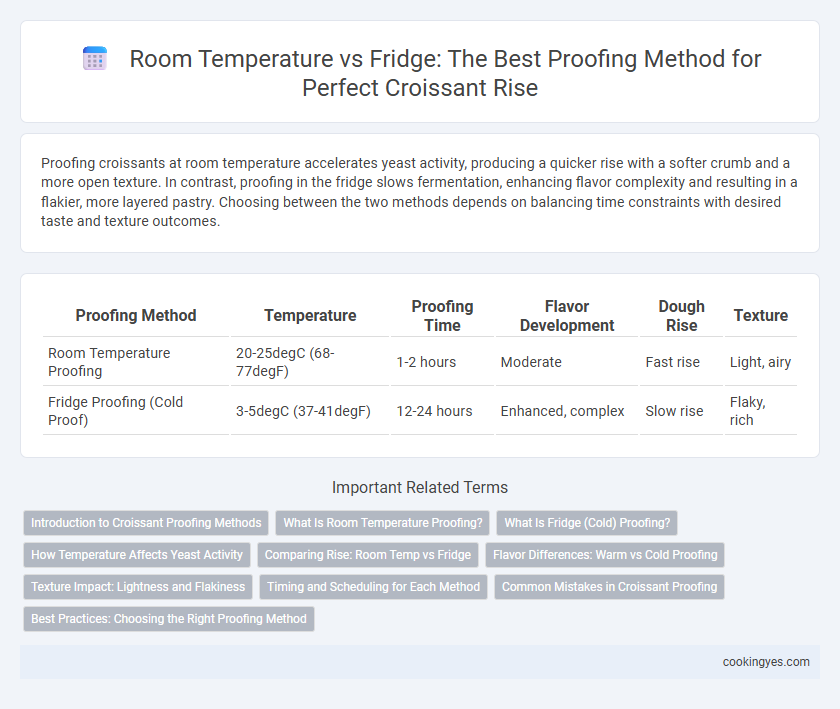Proofing croissants at room temperature accelerates yeast activity, producing a quicker rise with a softer crumb and a more open texture. In contrast, proofing in the fridge slows fermentation, enhancing flavor complexity and resulting in a flakier, more layered pastry. Choosing between the two methods depends on balancing time constraints with desired taste and texture outcomes.
Table of Comparison
| Proofing Method | Temperature | Proofing Time | Flavor Development | Dough Rise | Texture |
|---|---|---|---|---|---|
| Room Temperature Proofing | 20-25degC (68-77degF) | 1-2 hours | Moderate | Fast rise | Light, airy |
| Fridge Proofing (Cold Proof) | 3-5degC (37-41degF) | 12-24 hours | Enhanced, complex | Slow rise | Flaky, rich |
Introduction to Croissant Proofing Methods
Proofing croissants at room temperature typically takes 1-2 hours and encourages rapid yeast activity, resulting in a quicker rise and lighter layers. In contrast, proofing in the fridge slows fermentation over 8-12 hours, enhancing flavor complexity and flakiness through slow yeast metabolism. Choosing between these proofing methods depends on desired texture, flavor development, and baking schedule.
What Is Room Temperature Proofing?
Room temperature proofing for croissants involves allowing the dough to rise in a warm environment, typically between 70degF to 75degF, which accelerates yeast activity and promotes a quicker rise. This method enhances the dough's fermentation, developing flavor and expanding the layers for a flaky texture. Proofing at room temperature is preferred when time is limited or when a more pronounced rise is desired before baking.
What Is Fridge (Cold) Proofing?
Fridge proofing, also known as cold proofing, slows the fermentation process of croissant dough by keeping it at a low temperature, typically between 37degF and 45degF (3degC to 7degC). This method enhances flavor development as enzymes break down starches more slowly, resulting in a flakier texture and richer taste. Unlike room temperature proofing, cold proofing allows for extended rising time, improving dough stability and buttery layering.
How Temperature Affects Yeast Activity
Proofing croissants at room temperature speeds up yeast activity, resulting in a faster rise and a more pronounced fermentation flavor due to optimal warmth, typically around 75degF (24degC). In contrast, proofing in the fridge slows yeast metabolism significantly, allowing for a longer, slower rise that enhances dough flavor complexity and creates a flakier texture as gas production is gradual. The temperature difference directly controls carbon dioxide release rates, influencing the croissant's crumb structure and overall rise volume.
Comparing Rise: Room Temp vs Fridge
Proofing croissants at room temperature promotes a faster rise by activating yeast more quickly, resulting in a lighter, airier texture within 1 to 2 hours. In contrast, proofing in the fridge slows yeast activity, extending rise time to 8-12 hours but enhances flavor complexity and produces a flakier, more layered crumb. Optimal croissant rise balances fermentation time and temperature, with fridge proofing preferred for richer taste and better dough strength, while room temperature proofing prioritizes speed.
Flavor Differences: Warm vs Cold Proofing
Proofing croissants at room temperature accelerates yeast activity, yielding a softer texture and a mild, yeasty flavor, while cold proofing in the fridge slows fermentation, intensifying the buttery, nutty notes through extended enzymatic reactions. The cold method enhances flavor complexity and creates distinct layers due to slowed gluten development and fat crystallization. Bakers seeking a richer, more nuanced taste often prefer fridge proofing despite the longer rise time compared to the quicker, more straightforward warm proofing process.
Texture Impact: Lightness and Flakiness
Proofing croissants at room temperature accelerates yeast activity, producing a lighter texture with moderate flakiness due to faster gas expansion. In contrast, proofing in the fridge slows fermentation, enhancing flavor development and yielding a flakier, more layered crumb as the dough solidifies fats and strengthens gluten. Optimal croissant texture balances lightness and crisp flakiness, often achieved by a cold bulk fermentation followed by a short room temperature rise.
Timing and Scheduling for Each Method
Proofing croissants at room temperature typically takes 1 to 2 hours, allowing for quicker dough rise ideal for same-day baking schedules. Refrigerated proofing extends the process to 8-12 hours, slowing yeast activity for enhanced flavor development and flexible overnight preparation. Choosing between methods depends on bakery timing needs and desired croissant texture, with room temperature suited for rapid turnover and fridge proofing supporting delayed baking.
Common Mistakes in Croissant Proofing
Proofing croissants at room temperature often leads to over-proofing, causing a loss of dough structure and insufficient flakiness in the final product. Proofing in the fridge slows yeast activity, helping develop a more complex flavor and a better rise while maintaining dough integrity. Common mistakes include rushing proofing times or ignoring temperature control, resulting in uneven layers and suboptimal texture.
Best Practices: Choosing the Right Proofing Method
Proofing croissants at room temperature accelerates yeast activity, resulting in a faster rise but less complex flavor development. In contrast, proofing in the fridge enables a slower fermentation process, enhancing the dough's flavor and creating a flakier texture due to extended enzymatic reactions. For best results, cold proofing is recommended to achieve optimal rise, improved taste, and superior layering in croissants.
Proofing at room temperature vs proofing in fridge for croissant rise Infographic

 cookingyes.com
cookingyes.com